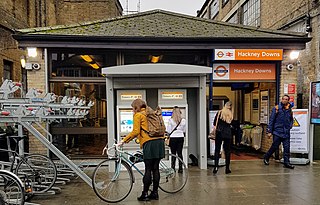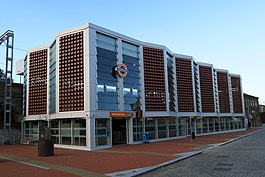
Seven Sisters is an interchange station located in the Seven Sisters area of the London Borough of Haringey, North London for London Underground, London Overground and National Rail services.

Rectory Road is a London Overground station on the Lea Valley lines in the West Hackney area of the London Borough of Hackney, east London.

Tottenham Hale is an interchange station located in Tottenham Hale, North London for London Underground and National Rail services.

Northumberland Park railway station is on the Lea Valley line that forms part of the West Anglia Main Line, serving the ward of Northumberland Park in Tottenham, north London. It is 6 miles 73 chains (11.1 km) down the line from London Liverpool Street and is situated between Tottenham Hale and Meridian Water. Its three-letter station code is NUM and it is in Travelcard zone 3. It is one of the stations that can be used to access Tottenham Hotspur Stadium.

Bruce Grove is a London Overground station on the Lea Valley lines located in central Tottenham in the London Borough of Haringey, north London. It is 6 miles 28 chains (10.2 km) down the line from London Liverpool Street and is situated between Seven Sisters and White Hart Lane. Its three-letter station code is BCV and it is in Travelcard zone 3.

Highams Park is a railway station on the Chingford branch of the Lea Valley lines, located in Highams Park in the London Borough of Waltham Forest, north-east London. It is 8 miles 52 chains (13.9 km) down the line from London Liverpool Street and is situated between Wood Street and Chingford. It has been operated by London Overground since 2015.

Silver Street is a London Overground station on the Lea Valley lines located in Edmonton in the London Borough of Enfield, north London. It is 7 miles 75 chains (12.8 km) down the line from London Liverpool Street and is situated between White Hart Lane and Edmonton Green.

Hackney Downs is a London Overground and National Rail station in Hackney Central and serves the old common land of Hackney Downs in Lower Clapton in the London Borough of Hackney, it is on the Lea Valley lines and West Anglia Main Line. It is 2 miles 78 chains (4.8 km) down the line from London Liverpool Street and has a direct passenger link to Hackney Central station, providing interchange with the North London line of the Overground network.

Bush Hill Park is a London Overground station on the Enfield Town branch of the Lea Valley lines, serving the neighbourhood of Bush Hill Park in the London Borough of Enfield, north London. It is 9 miles 69 chains (15.9 km) down the line from London Liverpool Street and is situated between Edmonton Green and Enfield Town, the terminus.

Edmonton Green is a London Overground station on the Lea Valley lines which formerly was a part of the West Anglia Main Line, located in Edmonton in the London Borough of Enfield, north London. It is 8 miles 45 chains (13.8 km) down the line from London Liverpool Street and is situated between Silver Street to the south and Bush Hill Park and Southbury to the north.

Stamford Hill is a London Overground station on the Lea Valley Lines, serving Stamford Hill and neighbouring areas. It is 5 miles 3 chains (8.1 km) down the line from London Liverpool Street and situated between Stoke Newington and Seven Sisters stations. Its three-letter station code is SMH and it is in Travelcard zone 3.

Southbury is a London Overground station on the Southbury Loop section of the Lea Valley lines, located on the easterly side of Enfield in north London. It is 10 miles 32 chains (16.7 km) down the line from London Liverpool Street and is situated between Edmonton Green and Turkey Street.

Turkey Street is a London Overground station on the Southbury Loop section of the Lea Valley lines, located in the Bullsmoor area to the north of Enfield in north London. It is 12 miles 16 chains (19.6 km) down the line from London Liverpool Street and is situated between Southbury and Theobalds Grove.

The Lea Valley lines are two commuter lines and two branches in north-east London, so named because they run along the Lower Lea Valley of the River Lea. They were part of the Great Eastern Railway, now part of the Anglia Route of Network Rail.

Broxbourne railway station is on the West Anglia Main Line serving the towns of Broxbourne and Hoddesdon in Hertfordshire, England. It is 17 miles 17 chains (27.7 km) down the line from London Liverpool Street and is situated between Cheshunt and Roydon. Its three-letter station code is BXB and it is in fare zone B.
Northumberland Park is a ward in the Tottenham area of London Borough of Haringey, in Greater London, England. It is largely residential, consisting of houses and flats. It is the location of Tottenham Hotspur Stadium, the home ground of Tottenham Hotspur F.C. The ward is represented by three Labour councillors. It is named after the Northumberland family who originally owned the land, the family included Harry Hotspur, who Tottenham Hotspur Football Club are named after.

Tottenham is a town in north London, England, within the London Borough of Haringey. It is located in the ceremonial county of Greater London. Tottenham is centred 6 mi (10 km) north-northeast of Charing Cross, bordering Edmonton to the north, Walthamstow, across the River Lea, to the east, and Stamford Hill to the south, with Wood Green and Harringay to the west.

The Southbury Loop is a line linking Edmonton Green, in north-east London, to Cheshunt. It was opened by the Great Eastern Railway in 1891. Initially it was not very successful and was closed to passenger traffic in 1909. Goods trains continued to use the line and during World War I passenger services were reinstated for munitions workers. Once the war finished the line returned to its goods-only status although it was occasionally used for diversionary purposes when the West Anglia Main Line was closed south of Cheshunt. Electrification of the line and the reintroduction of passenger services in 1960 saw the line become busy with regular suburban services as part of the Lea Valley Lines network. Since May 2015 passenger services on the line are part of London Overground.
The Enfield Town branch is a suburban branch line in the England. In 2014 it is in fact the combination of the original Enfield branch which was built in 1849 by the Eastern Counties Railway (ECR) and a later line built by the Great Eastern Railway (GER) from Hackney Downs to Edmonton in 1872. The line is currently a double-tracked suburban railway with services running between Liverpool Street station and Enfield Town as well as some other services running from Liverpool Street to Cheshunt. Part of the original branch is closed and little visible remains today.

White Hart Lane is an electoral ward mainly in Tottenham, London Borough of Haringey, London, with some parts located in neighbouring Wood Green and Palmers Green. The ward is represented by three Labour councillors.























